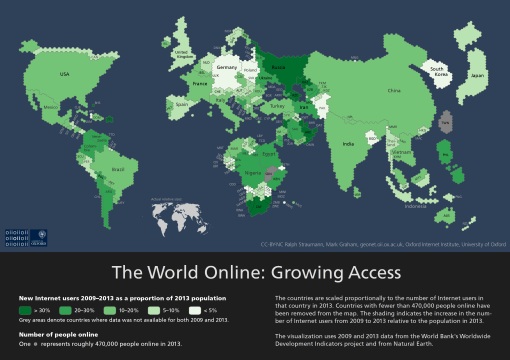If you had to imagine what the Internet looked like, what would come to mind? This seemingly innocent question has given rise to some interesting and occasionally bizarre representations. There are the physical aspects, the infrastructure that makes it possible, the hardware that runs it, the software that interfaces with people and then there are the people themselves. There is a whole other conceptual side to it, which strays into realms of the human mind, and even the name cyberspace congers up visions of some universe within our own, but that is ill defined in physical space. The prefix cyber cyber comes from the Greek word kybernet, meaning to steer or guide (a helmsman), from which cybernetic is derived. One can appreciate the irony there and does the internet do the steering or the people using it? Well, this is a big topic and the many questions raised are outside the scope of this blog. When it comes to visualizing the internet I tend to like maps of the world that reflect human behavior or trends in activity. I showed some in a previous blog from June, 2014: The Internet – Yesterday to Today. The maps shown here show the who and how people are connected:
In viewing some of these maps, I began to wonder what my own WordPress map of visitors compared to some of these. Turns out it actually looks fairly similar for the most part and is most easily compared with the map of Internet users per 100 people and Map of Internet Freedom. Below I show my map of visitors to Cogito Ergo during the period 2012 to 2015, and the associated list of countries with number of visits below that. All total, this blog has had more that ~11,000 views; ~6,000 visitors. On a monthly basis there are an average of 276 views; 163 visitors; 1.78 views per visitor. Currently there are 117 posts, 40 categories and 230 tags. I just record these stats for posterity and reference, and not sure they are of much interest to anyone. The map and countries below only reflect 2012-2015 since I activated the mapping feature, not the total numbers since I started this WordPress blog in 2011 and migrated all my previous years blogs here from another platform. I have actually been writing this blog for just about 10 years now. It may be time to give it a rest for a while and pondering a hiatus in 2016.
This idea of Mapping the Internet is likely to expand in the future. It’s not just about the technical details or the purview of science to tell. Science is good at telling us how thing work, but not why they work or what they are good for. For example, we can figure out how the universe works, but not really why it works that way or why it exists. The future will have to go beyond the science and statistics of things and delve deeper into the relationship of man and machine. Mankind has been mapping the physical space on earth and outer space for millennia. The physical space of the human body and inner space of the human mind the brain has been explored for centuries and we are just beginning to map it. This thing called the Internet or cyberspace is as vast and complex I think than even we realize – like the universe itself or the human brain. In this case, however, the creator will be examining his creation. The ultimate Mapping of the Internet may reveal the creator in a new light, hopefully not Man the God, but Man the inquisitive explorer. Ultimately man is a temporary tenant of Planet Earth. Reaching into inner space or cyberspace to see ourselves may someday inspire us to reach for the stars. I like that line from the 2014 film Interstellar:
“Man was born on Earth, but he wasn’t meant to die here.”
I give some links for Internet Map exploration:
Global Internet Maps
The Internet Map
Geonet
Internet Census 2012
The Opte Project
Ways to Map the Internet
.







